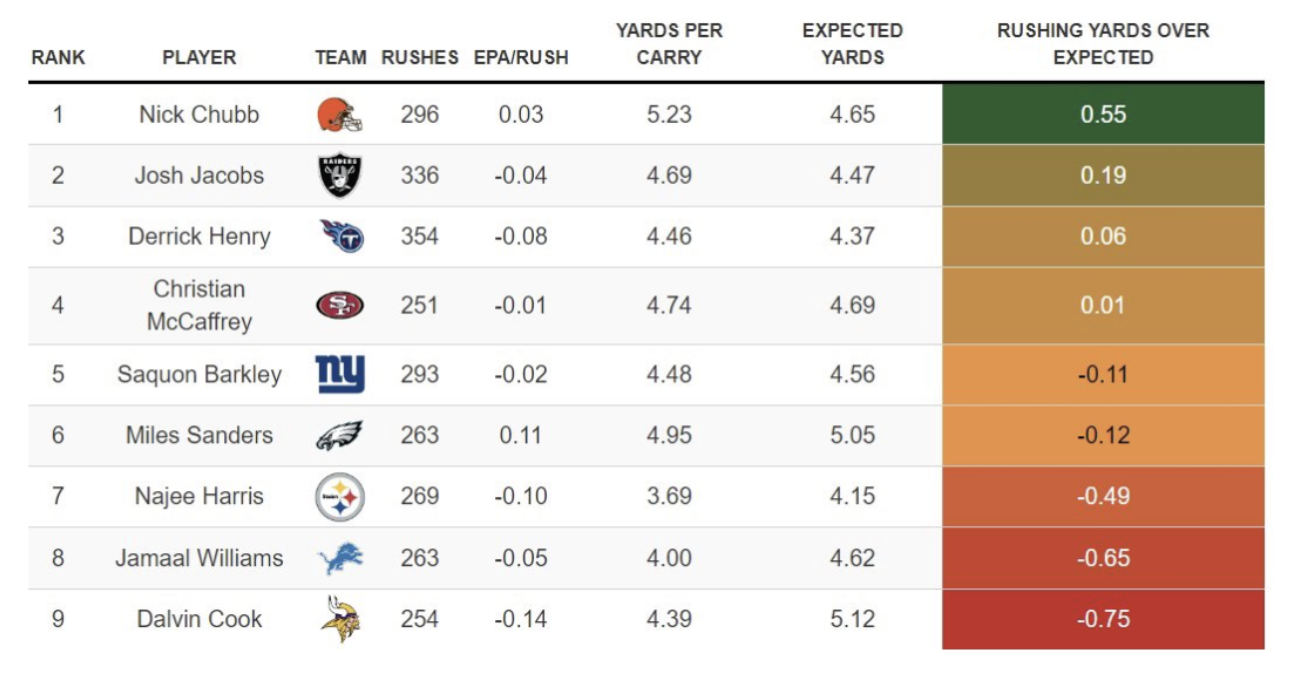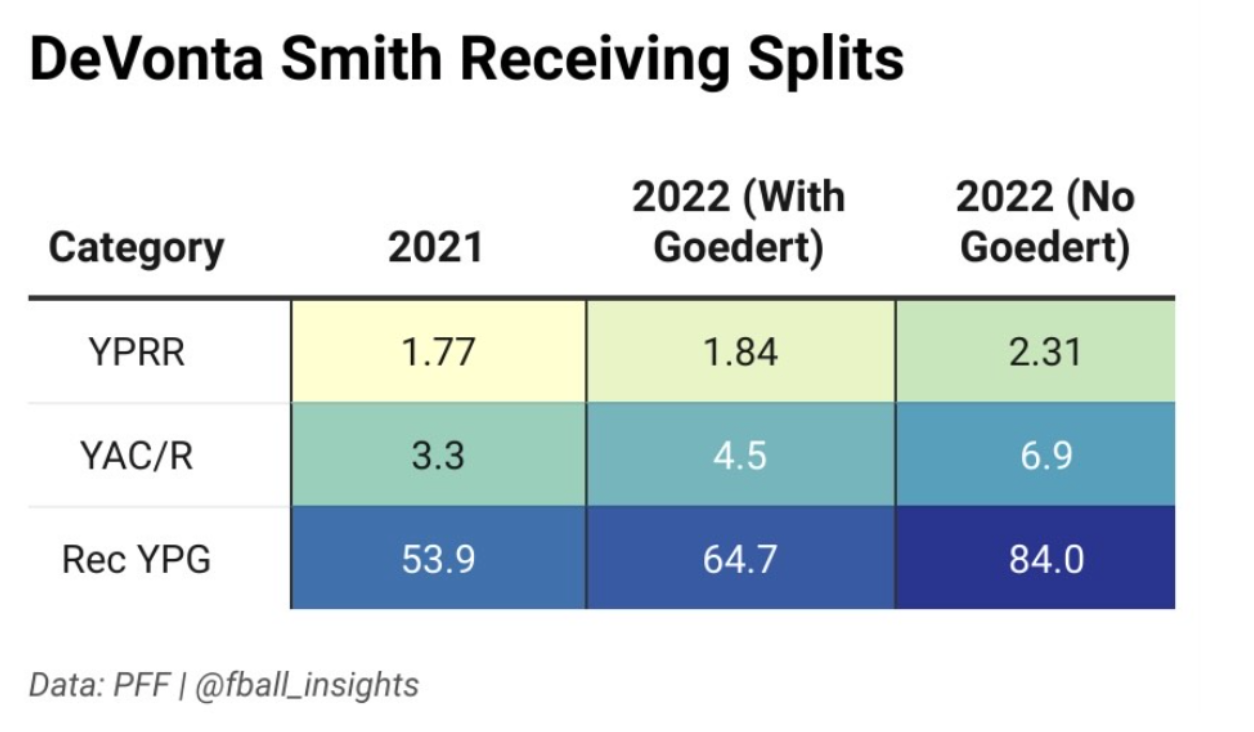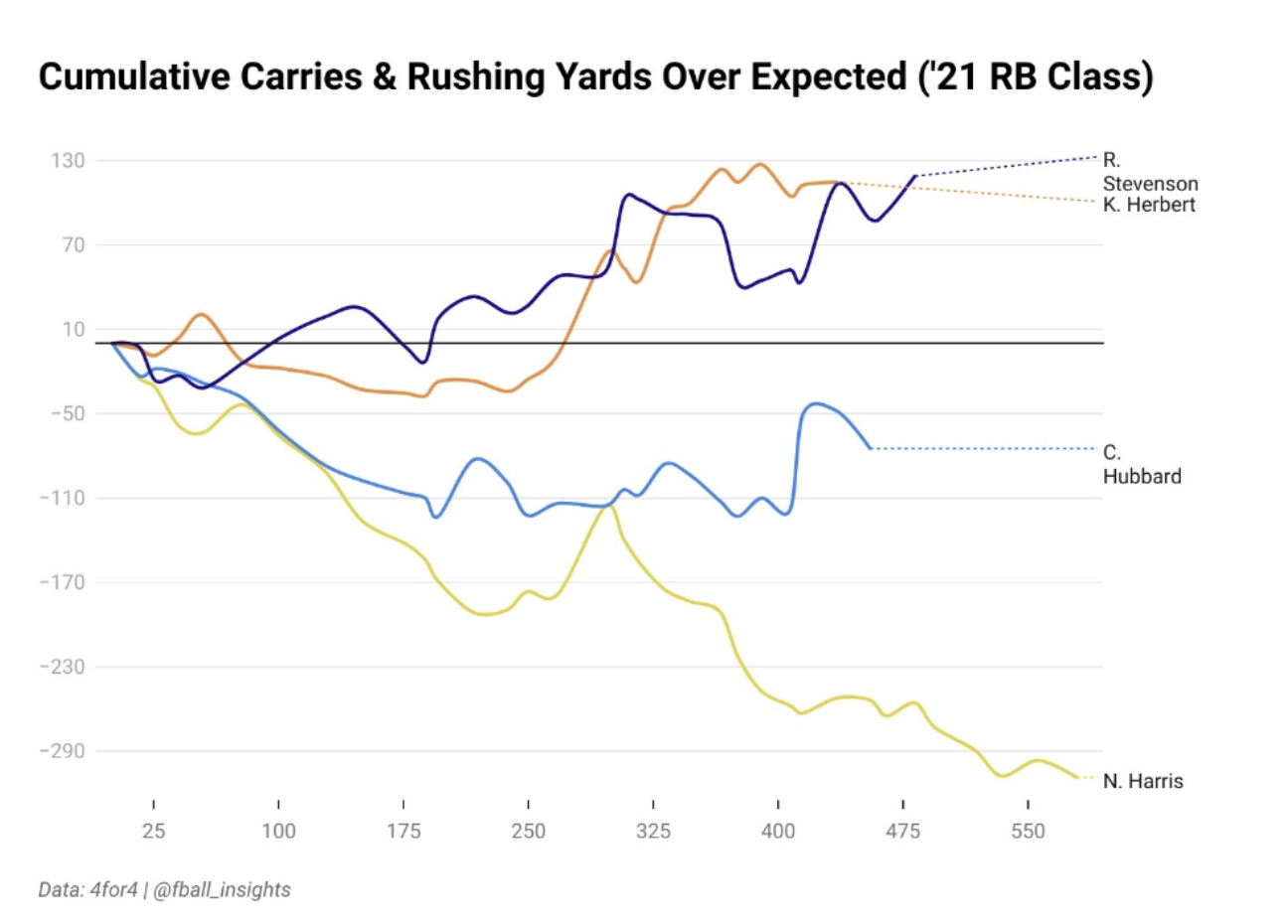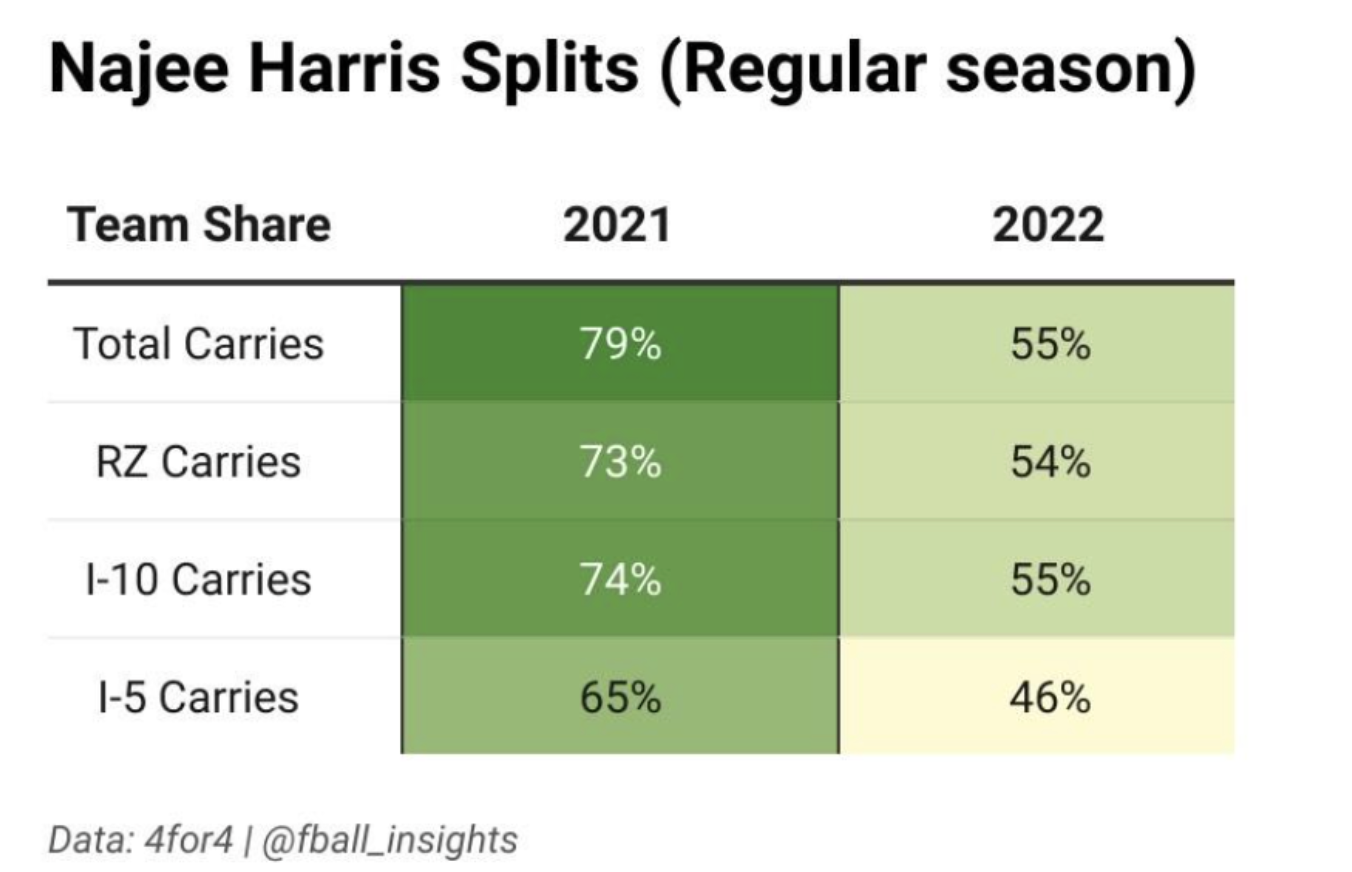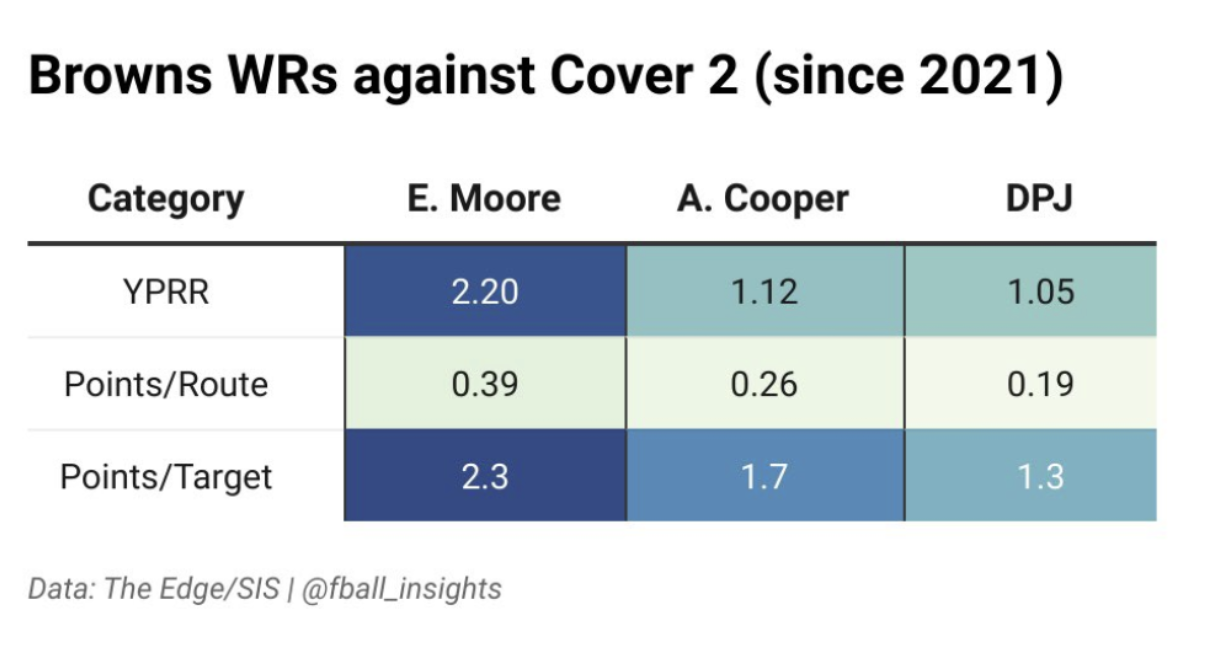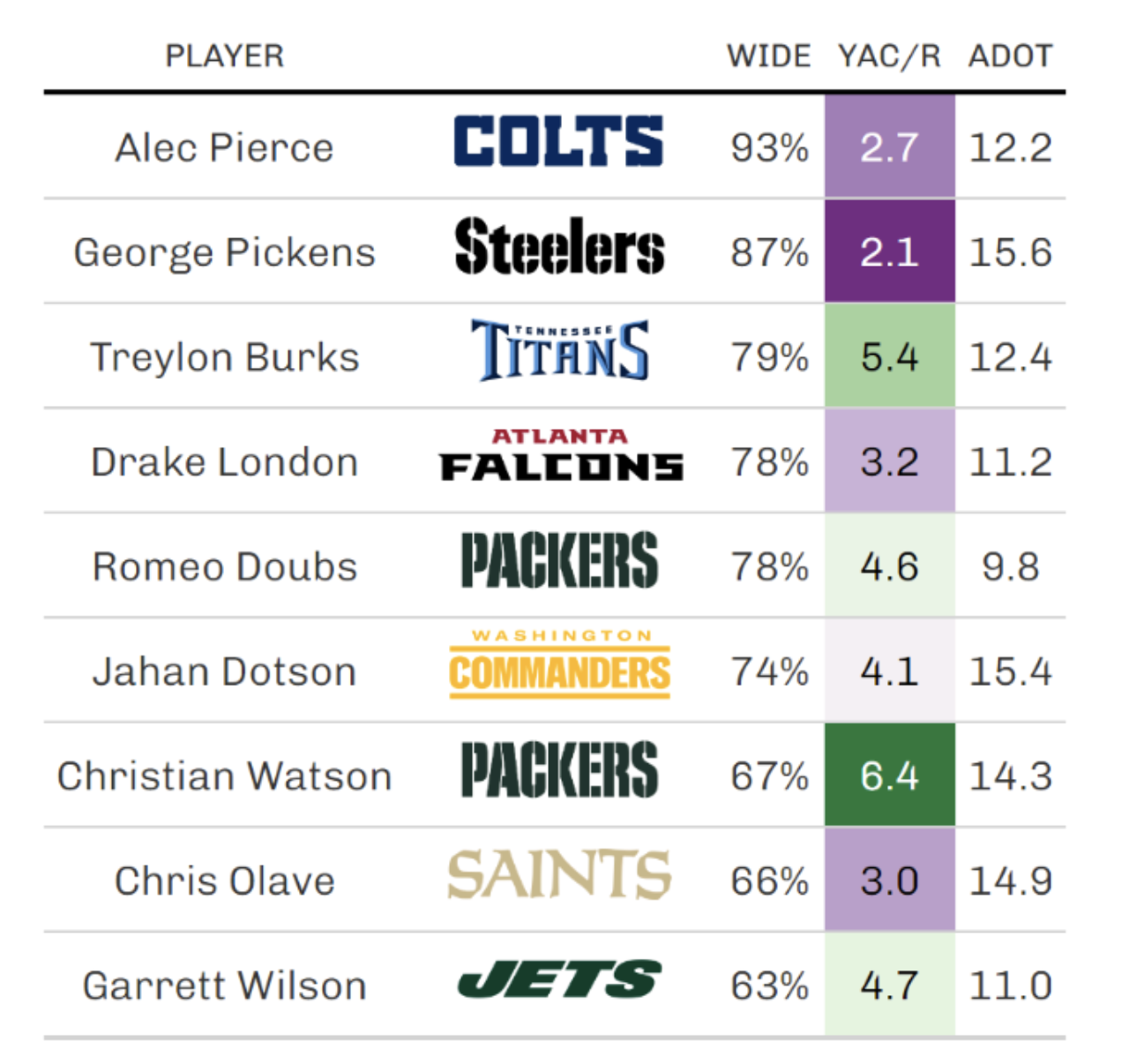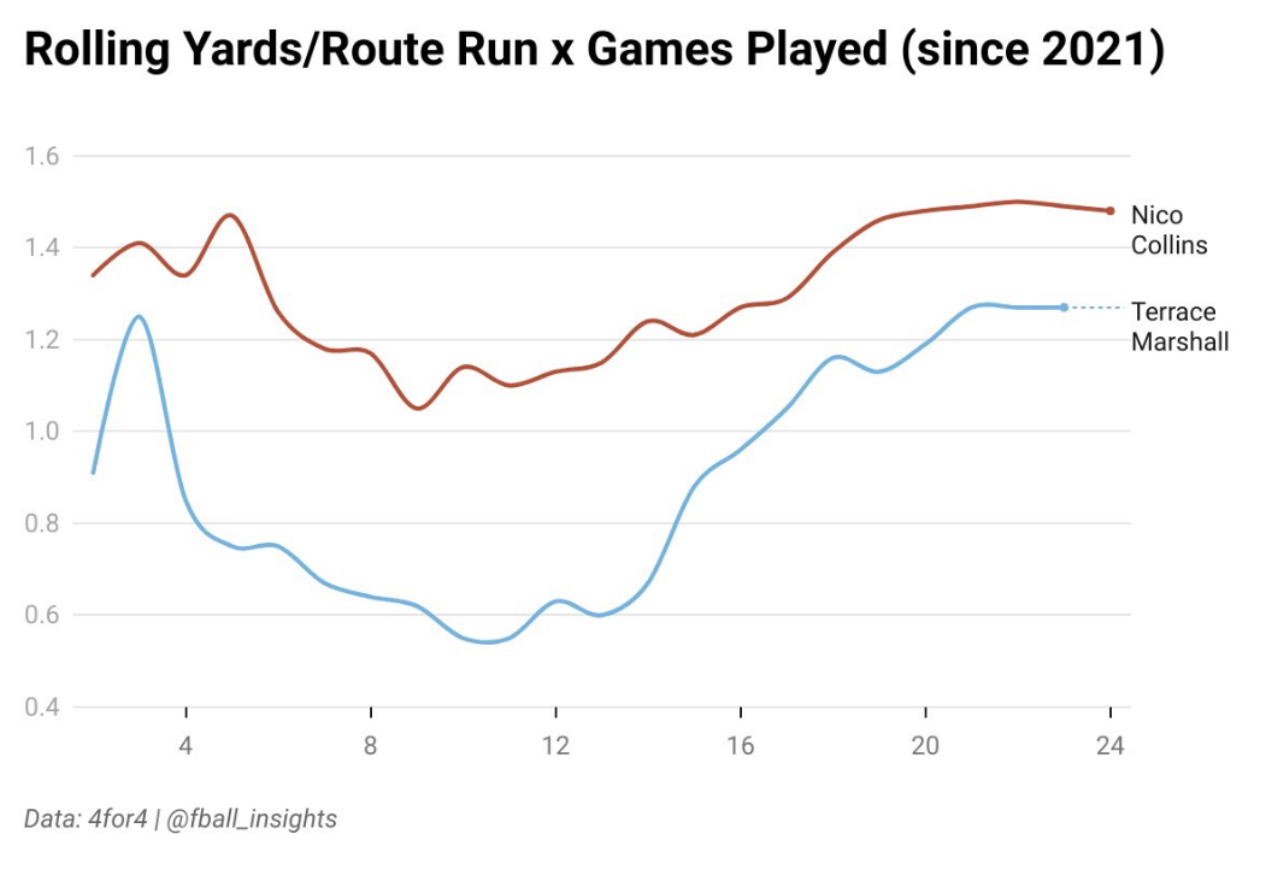I originally laid out the framework and six candidates for this article prior to the NFL Draft. By the time you’re reading this, all thirty-two teams will have made their selections.
That process was critical. Isolating a player’s individual trajectory and “baking in” any potential externalities that could’ve been added help narrow our range of outcomes.
With all that being said, here are three overvalued and undervalued players in 2023 dynasty fantasy football.
Overvalued: Dalvin Cook, RB, Min
ADP: 77.83 (RB25)
It appears as though we may have seen the last of RB Dalvin Cook and his tenure with the Minnesota Vikings.
Since entering the league in 2017, Cook’s trajectory is pretty straight forward for an aging running back. This is before considering a potential $14 million cap hit if a restructure doesn’t take place.
Cook ranked dead last in rushing yards over expected per carry among RBs with 250+ attempts last year, and it’s not like he had to overcome many detrimental externals on offense. Minnesota owned a top-five PFF run blocking unit in 2022, yet he and teammate Alexander Mattison both ran worse than expected.
Even if we were to assume Cook stayed put this year, the Vikings already re-signed Mattison and poached UAB running back DeWayne McBride on Day 3 of the draft.
It’s difficult to imagine anything other than a departure at this point. Cook’s sheer presence on the field became too much of a liability to justify his cap hit, let alone majority of the backfield
work. Cook was the league’s only running back to allow double-digit quarterback pressures (13) and hurries (10) as a pass blocker during the regular season.
Cook is now at the point in his career where the rug could be pulled from underneath him at any moment. As rumors of a potential trade continue to circulate, I would suggest capitalizing on the recent hype and attain something for him if a deal indeed unfolds.
Overvalued: DeVonta Smith, WR, Phi
ADP: 23.33 (WR13)
Skinny Batman may come as a surprise here, but now might be a good time to maximize his value.
Many, including myself, rave of the ways in which A.J. Brown opened things up for the Philadelphia Eagles’ offense. Not only did this acquisition boost their newly paid quarterback Jalen Hurts, it made life easier for DeVonta Smith and their secondary pass catchers.
Looking at regular season numbers, Smith saw 12% of his pass play snaps from the slot as a rookie, which jumped to 25% in 2022. He also experienced a downtick in average depth of target from 15.2 to 9.9. Everyone acknowledges Brown’s impact in becoming their primary X receiver, but Smith’s added slot work/gadgetry schemed him some underrated production.
Over 21% of Smith’s receptions came from screen passes. Among all wideouts with 100+ targets last season, he posted the second-highest screen target rate at 15.2%.
If you take the time missed by TE Dallas Goedert over the middle parts of the season into full consideration, Smith’s sophomore splits aren’t as noteworthy:
Smith’s air yards share regressed when both Goedert/Brown played, and his YAC was juiced up by screens. Plus, his average cushion from the nearest defender grew from his rookie year.
Smith is a nice number two or three, and overall is an above-average wide receiver. But when you isolate some of those externals at large, he didn’t make the star-studded jump some have claimed.
Overvalued: Najee Harris, RB, Pit
ADP: 39.17 (RB12)
Many of you abide by the sentiment of “talent over situation” — a solid rule of thumb across indefinite time horizons that is dynasty football.
Isolating performance can be messy, depending on position and any biases that could over/underweight statistical evidence.
Not much data is encouraging for Steelers RB Najee Harris. It could be time to capitalize on his “RB1” status before it’s too late.
Najee led all running backs with 579 total rush attempts across each of the last two regular seasons. Opportunities haven’t been an issue, but efficiency has.
Harris averaged -0.62 rushing yards over expected per attempt in 2022, the worst output among rushers with at least 200 carries.
Looking at cumulative RYOE within Najee’s draft class — his trajectory is quite alarming.
Where are things falling?
Harris exhibited less red zone work in his second year, key staples of fantasy output (ex. Jamaal Williams with Detroit).
Najee’s role in the passing attack is no exception. He ran 21+ routes per game as a rookie, which sunk to 14.7 in 2022. Likewise, his target per route run regressed from 26% to 21% during his sophomore campaign.
Harris did suffer a Lisfranc sprain last August, which lingered until the second half (right about when things began picking up), and Pittsburgh drafted zero ball carriers after entertaining at least nine this offseason (which could, of course, increase trade return for Harris). But it’s no coincidence that first-year RB Jaylen Warren led the positional room in third-down snap share.
Consider this your official “buyer beware” Najee warning in dynasty formats.
Undervalued: Elijah Moore, WR, Cle
ADP: 96 (WR 47)
A wise man once said “trail players that competitive teams acquire.” This sentiment, along with the atrocious situation that was the Jets in 2022, combined to provide Elijah Moore truthers at another shot.
New York shipped Moore (along with a third-round pick) to Cleveland this past March.
Considering he actually produced as a rookie, it makes a change of scenery a bit more encouraging.
It’s my belief that the Browns recognize Moore’s strengths and will put him in more favorable situations.
Moore is efficient against two-high shells, something defenses have emphasized across the NFL and a coverage that WR1 Amari Cooper and Donovan Peoples-Jones have struggled with.
HC Kevin Stefanski riled up the analytics crowd with an encouraging message regarding Cleveland’s passing attack. Going into year two (and a full season for the QB that shall not be named), one would expect an uptick in volume through the air.
Cooper and Peoples-Jones shared roughly 75/25 splits outside/from the slot last year. Deploying the shifty Elijah Moore compliments a deep threat in DPJ nicely on the underneath stuff and likely shares a similar pattern with third-round WR Cedric Tillman, who produced from the outside while at Tennessee.
Among all players with 300+ routes in each of the last two seasons, Moore experienced the worst targets per route run decrease from 24% to 12%.
Even before accounting the arrival of Garrett Wilson, Moore’s fall from grace seems too drastic to consider “this” as his baseline for future production.
Undervalued: Treylon Burks, WR, Ten
ADP: 42.33 (WR23)
Due to injury, Titans WR Treylon Burks compiled just 8 games with 20+ routes as a rookie, but his current price in dynasty formats is a deal to take advantage of.
An overarching theme dating back to Burks’ Arkansas days is size combined with yards after the catch ability. Burks averaged 5.4 yards after the catch per reception during the regular season, twelfth-best among all wideouts with 50+ targets, per PFF.
This skillset has translated and it’s even more impressive once you factor the context:
Over 75% of Burks’ snaps came from the outside, a sufficient jump from his 17% clip in college.
Some were concerned with Burks’ high slot usage going into the draft, mainly if it inflated his production/separation. Well, only Christian Watson averaged more YAC within this class and even he was sub-70% from out wide.
Treylon Burks is more like Garrett Wilson with the ball in his hands than the likes of Chris Olave or Drake London.
The alignment frequency is critical because teammate Chigoziem Okonkwo raised eyebrows as a pass catching threat from the tight end position. On top of that, last year’s WR1 Robert Woods is now in Houston and Tennessee allocated just one seventh-round pick towards the position in last week’s draft.
Burks’ health and externals should only continue to improve throughout the remainder of his rookie contract. Lining up on the outside as a hedge to Okonkwo makes Burks a breakout candidate for the 2023 season.
Undervalued: Nico Collins, WR, Hou
ADP: 157.83 (WR67)
WR Nico Collins capped off his sophomore campaign by ebbing through the many production barriers prominent within the Houston Texans’ offense.
Last season, Collins was targeted on 24% of his routes against man coverage, up from 11% as a rookie in 2021 (4for4).
Houston’s quarterback room put up an abysmal 26% off-target rate on pass attempts to Collins, second-worst for any qualified pass catcher in 2022.
The Texans dealt veteran Brandin Cooks to the Cowboys while acquiring Robert Woods, Noah Brown and Dalton Schultz this offseason. Likewise, WR John Metchie is fully participating in workouts after battling leukemia his rookie year (awesome news about his recovery), and the team selected Houston's-own Tank Dell on day-two of the draft.
Obviously these additions are collectively more mouths to feed, but Collins stands as the team’s perennial weapon downfield and from high value areas in one-on-one situations.
Collins caught 12 of 16 contested targets last season, which only helps his case for more opportunities as a reliable weapon for second-overall pick C.J. Stroud.
There’s bias stemming from the spoils of immediate “hits” in recent years, which write off players like Collins too early. He’s on a normal trajectory that many wideouts have demonstrated in the past and is well worth the level of assets to acquire.


